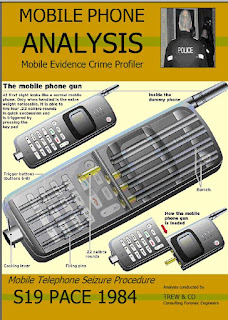Sound Waves Could Power Cell Phone?
.Cell phones are only useful so long as they have charge left in the battery, may not be an obvious comment to make when looking at the future as to how cell phones may be powered. Pioneering work, by Professor Tahir Cagin at the Artie McFerrin Department of Chemical Engineering at Texas A&M University, in the area of 'sounds waves' to help cell phones generate self-power could revolutionise, and have profound impact on, 'power harvesting' in the future, and not just for cell phones either, but other lower powered devices, such as radios, laptops, pagers, PMR etc.
.
The way it works, sound waves produced by the user of a cell phone can generate the energy the cell phone needs to operate. The science behind this is generated from materials know as "piezoelectrics". Professor Cagin's research focused on nanotechnology and made the significant discovery in the area of 'power harvesting', "found that a certain type of piezoelectric material can convert energy at a 100 percent increase when manufactured at a very small size – in this case, around 21 nanometers in thickness." To comprehend the minute level at which this work is carried out, nanometers are a microscopic unit of measurement representing one-billionth of a meter. Atoms and molecules are measured in nanometers, and a human hair is about 100,000 nanometers wide.
 Polarizable Charge Equilibration Interaction
Polarizable Charge Equilibration Interaction Potentials are essential in describing piezo-
and ferro-electricity in ABO3 ceramics for sensors,
actuators and energy harvesting applications.
.
Chambers Science and Technology Dictionary identifies the term 'piezo' is derived from the Greek word 'piezein', a verb meaning 'to press'. In 1880, French scientists P.& J. Curie discovered "Those crystals having one or more axes whose ends are unlike, that is to say hemihedral crystals with oblique faces, have the special physical property of giving rise to two electrical poles of opposite signs at the extremities of these axes when they are subjected to a change in temperature: this is the phenomenon known under the name of pyroelectricity." They went on to state, "We have found a new method for the development of polar electricity in these same crystals, consisting in subjecting them to variations in pressure along their hemihedral axes." [Curie, P. and J. Curie, Development by pressure of polar electricity in hemihedral crystals with inclined faces. Bull. soc. min. de France, 1880. 3: p. 90-93.].
.
From the research I conducted into 'piezoelectrics' it suggests that it is not a new science, per se. Thus, has this science been used for any other technologies that took advantage of the ability of certain crystalline or ceramic materials to develop an electric charge proportionally generated from some form of stress presented to them? Examples that I was able to find on the Internet: the spark that ignites the fuel in a lighter occurs due to pressure of the lighter button impacting on a piezoelectric crystal; night clubs that use piezoelectrics built into the floors that absorb the energy of dancers foot-movements to provide energy to power the lights; the same principle applied to using gymnasium equipment to provide energy is yet another example. Indeed, walking can help produce the same energy to generate back up power supplies. Professor Cagin's further discovery of researching the basic laws of physics that relates to human speech (pressure) and from that to 'power harvest' from speech waves to generate energy can only add to the incredible scientific phenomenon that piezoelectrics has become.
.
Extrapolating what might be possible should such a science be implemented into mobile telephones, certainly users would like it as they may never again need to obtain another battery when the life-span of a battery has been reached, no recharging at the electric socket, or have a flat battery preventing mobile calls until the battery is recharged back at home or the office. I should imagine mobile network operators would love this technology, too, as it implies more people will have an excuse to spend even more time yakking on the mobile, thus call traffic revenues could increase. From a climate greenhouse emissions standpoint it should be an exciting draw, particularly for Government, because piezoelectrics allows for renewable energies with minimal carbon-footprint, apparently.
.
Some downsides: how will battery manufacturers see their future?; train and bus passenger complaints will probably increase about other passengers using their mobile phones in carriages etc, not convinced by the mobile phone user-offenders claiming they are only recharging their phones; for mobile phone examiners, though, this could be problematical for mobile phones exhibits with no-charge in them to operate and conduct data acquisition. How to energise the phone will be one question needing to be answered? Evidentially, having to admit the mobile phone examiner had been chatting on the phone to power it raises all sorts of issues, and what about when the examiner has 20 phones to be turned around quickly?
.
Source of scientific development and photo: Texas A&M University
 .
.






















